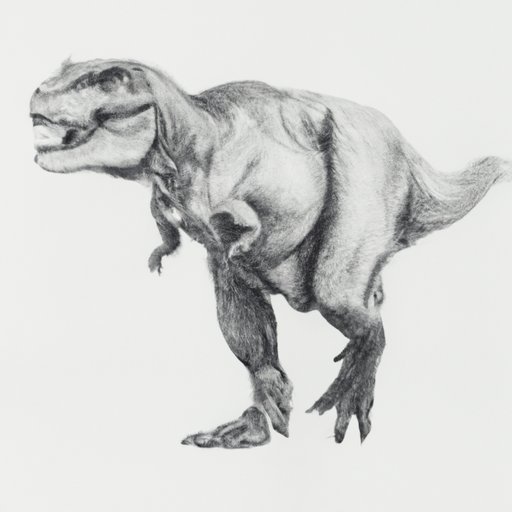
How to Draw a T. Rex: Step-by-Step Instructions, Tips, and Tricks
Learning how to draw a T. rex can be a fun and rewarding experience for art enthusiasts and dinosaur lovers alike. Whether you’re a beginner or an experienced artist, drawing a T. rex can be a great way to improve your skills and challenge your creativity. In this article, we’ll provide step-by-step instructions, tips, and tricks for drawing a T. rex that looks realistic and impressive.
Materials Needed
Before we begin, let’s gather the necessary materials to draw a T. rex:
- Sketchpad or paper
- Pencil and eraser
- Reference material such as photos or videos of T. rex
Step-by-Step Instructions
Let’s begin our step-by-step instructions for drawing a T. rex:
Step 1: Draw the Body
Start by drawing a large oval for the torso, and a smaller oval near the top for the head. Draw two lines extending from the body for the legs, and two smaller lines for the short arms.
Step 2: Add the Head
Refine the head by shaping it to be wider at the back of the skull and narrowing down towards the snout. Draw in details such as the eyes, nostrils, and jaws. T. rex had thick brows and muscular jaws, so keep those details in mind while sketching.
Step 3: Sketch the Legs
Draw the thick legs of the T. rex. Heavier and more muscular than the arms, the legs will give your T. rex drawing a strong, sturdy look. You can add some details in the calves part.
Step 4: Draw the Tail
End the T. rex sketch with a long and strong tail to balance the weight of the torso and enhance the visual flow. Typically, a T. rex’s tail would have more scales than the rest of its body, so feel free to add some details there.
Using Reference Material
The importance of using reference material cannot be overemphasized. You can easily access a vast amount of reference material online, such as photos or videos of T. rex specimens, to make your drawing look more accurate and lifelike.
When using reference material, be sure to observe the T. rex’s anatomy, muscle structure, and texture. Take note of its unique features and incorporate them naturally in your drawing.
Different Styles of T. Rex Drawing
There are various styles of T. rex drawing, each with its unique interpretation and visual style. Here are three popular styles:
Realistic
Realistic style drawings of T. rex focuses more on anatomical accuracy, realistic skin texture and detailed shading. These drawings tend to give a naturalistic and classic paleontologist vibe.
Cartoonish
Cartoonish style T. rex drawings are whimsical and exaggerated. These drawings are often used for children’s books and comic strips. Cartoonish T. rex is great if you just want to have fun or use it as a design element for a piece of art.
Fantasy
Fantasy style T. rex drawings are not based on any strict scientific rules and use a fictional world in terms of colors and features. These fantasy-style drawings allow the artists to use their imagination to add unique and magical ideas to their drawings
Adding Details
Once you have the basic outline of the T. rex, you can start adding more details to make it more interesting. Some details that you might add include:
- Scales: dinosaurs are commonly recognized for their sweeping scales. Work on these scales by adding an outline of scale lines along the body, tail and legs.
- Teeth: T. rex had a formidable set of teeth. Add these teeth drawing by carefully sketching in long and sharp teeth on the exterior jaw
- Facial Features: T. rex had a distinct skull shape, with a deep and wide snout definitely standing out. Sketch in the bone structure details, as well as the brow ridges and eyes.
Common Mistakes
When drawing T. rex, it’s easy to fall into some common mistakes. Here are some of them, and how to avoid them:
- Proportions: Be sure to get the proportions right among different parts of T. rex’s body. Use reference material to help maintain consistency.
- Detail Overload: Another common mistake is going overboard with detailing while drawing a T. rex. Work in small bits incrementally, instead of aiming for the entire detailed feature at once.
- Shaky Lines: Finally, avoid making too many wobbly/wavy lines; shaky lines can frequently be less appealing. Use confident, swift lines when adding details.
Conclusion
Drawing a T. rex may seem intimidating at first, but with the right materials, reference material, and techniques, you can create a T. rex that looks professional and engaging. Keep practicing, notice your own common mistakes and expand your skills confidently.





